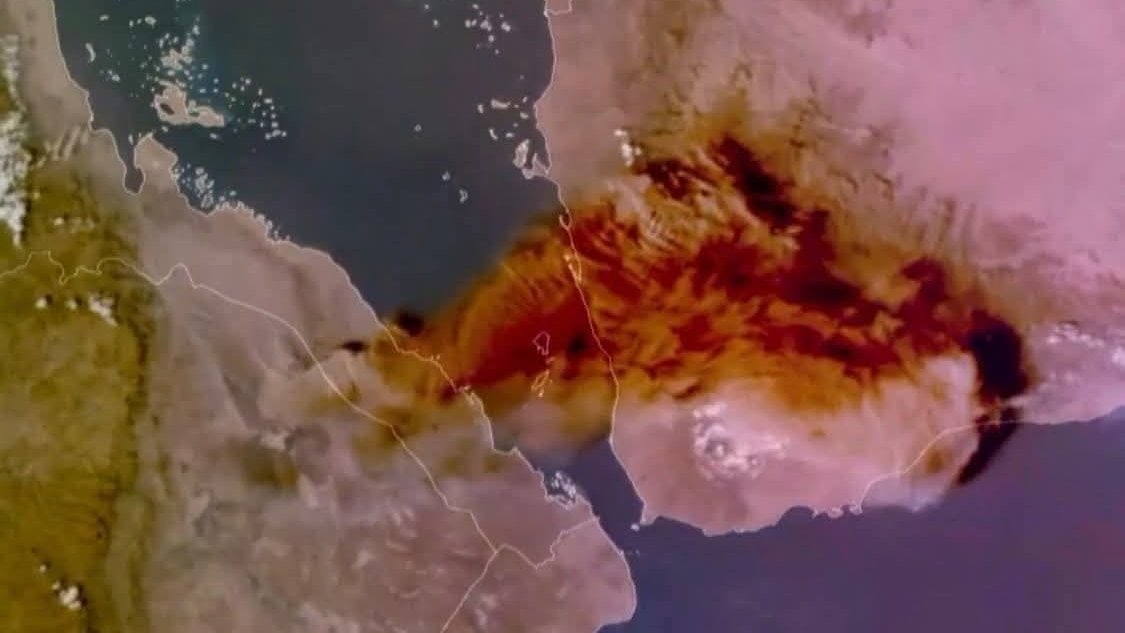
Explosive volcanic eruption sends a massive ash plume drifting from Ethiopia toward Yemen and Oman — Volcano Discovery / Getty Images
Last updated on: 24-11-2025 at 8 PM Aden Time
|
|
Aden (South24 Center)
The General Authority of Civil Aviation and Meteorology in Aden reported on Monday (November 24) that large parts of Yemen have been affected in recent hours by volcanic ash clouds from Ethiopia, following a sudden eruption near the Erta Ale range in the Afar region; an event Ethiopian media described as the first of its kind in thousands of years.
The Weather Forecast and Early Warning Center said satellite imagery showed ash clouds moving from one of the volcanic cones near Erta Ale toward Yemen, carried by prevailing winds. Volcanic cones are steep-sided hills formed by volcanic eruptions. The center added that the clouds contain fine particles of volcanic rock and glass, which are tiny fragments produced during eruptions. These fine particles can be harmful when inhaled or when they settle on surfaces, and they can travel long distances, potentially reaching neighboring countries.
Local Ethiopian media, including Afar TV, reported that a “massive explosion” of volcano Hayli Gubbi produced a dense ash column that blanketed villages in the Danakil region, forcing evacuations and disrupting transportation as visibility dropped to near zero, according to Addis Standard.
International volcanic monitoring agencies, including the Toulouse Volcanic Ash Advisory Center (VAAC), confirmed that the plume rose to more than 45,000 feet before activity subsided, while warning maps indicated ash drifting at lower levels toward Djibouti and Yemen.
The Aden Meteorological Authority said the impact of the ash clouds will vary across different regions of the country and urged residents to follow safety guidelines. It advised asthma patients, the elderly, and children to minimize outdoor exposure, keep windows closed, and use masks, when necessary, until the clouds’ effects subside.
The center added that it is monitoring ash movement around the clock and called on media and local authorities to rely on updates issued by the Aden Meteorological Authority, the official body responsible for monitoring.
In a subsequent statement, the Aden Geological Survey Authority said satellite imagery indicated that volcanic dust is beginning to recede from Yemen’s airspace, while specialized teams continue to track potential changes in the clouds’ trajectory over the coming hours.
In an updated scientific bulletin on Monday, the Aden-based Geological Survey and Mineral Resources Authority said new satellite analyses from global Volcanic Ash Tracking Systems show the ash and sulfur dioxide plume extending across several atmospheric layers, reaching altitudes of 10 to 18 kilometers—levels consistent with high-energy explosive eruptions. The authority noted that the cloud is gradually thinning as it moves west and northwest, with no current indication of a direct impact on air quality in Yemen. It stressed that there is no cause for concern and that monitoring is ongoing in coordination with regional and international centers as a precautionary measure.
This development comes after scientific warnings that the Danakil region, situated along the East African Rift, is prone to recurrent geological activity. According to experts, this is the first eruption at the site in several thousand years, and ash traveling on high-altitude winds could have lasting effects over a wide area.